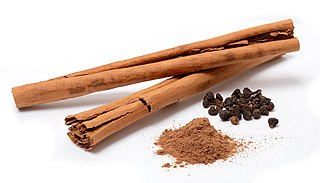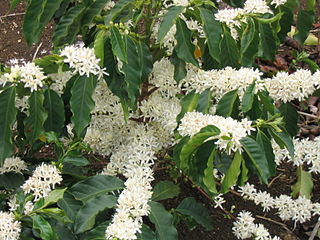
Cinnamon is a spice obtained from the inner bark of several tree species from the genus Cinnamomum. Cinnamon is used mainly as an aromatic condiment and flavouring additive in a wide variety of cuisines, sweet and savoury dishes, breakfast cereals, snack foods, bagels, teas, hot chocolate and traditional foods. The aroma and flavour of cinnamon derive from its essential oil and principal component, cinnamaldehyde, as well as numerous other constituents including eugenol.

Cinnamomum cassia, called Chinese cassia or Chinese cinnamon, is an evergreen tree originating in southern China and widely cultivated there and elsewhere in South and Southeast Asia. It is one of several species of Cinnamomum used primarily for its aromatic bark, which is used as a spice. The buds are also used as a spice, especially in India, and were used by the ancient Romans.

Horton Plains National Park is a national park in the central highlands of Sri Lanka that was designated in 1988. It is located at an elevation of 2,100–2,300 m (6,900–7,500 ft) and encompasses montane grassland and cloud forest. It is rich in biodiversity and many species found here are endemic to the region. It is also a popular tourist destination and is situated 8 kilometres (5.0 mi) from Ohiya, 6 kilometres (3.7 mi) from the world-famous Ohiya Gap/Dondra Watch and 32 kilometres (20 mi) from Nuwara Eliya.

Coffea arabica, also known as the Arabica coffee, is a species of flowering plant in the coffee and madder family Rubiaceae. It is believed to be the first species of coffee to have been cultivated and is the dominant cultivar, representing about 60% of global production. Coffee produced from the less acidic, more bitter, and more highly caffeinated robusta bean makes up most of the remaining coffee production. The natural populations of Coffea arabica are restricted to the forests of South Ethiopia and Yemen.

Cassia fistula, also known as golden shower, purging cassia, Indian laburnum, kani konna, or pudding-pipe tree, is a flowering plant in the family Fabaceae. The species is native to the Indian subcontinent and adjacent regions of Southeast Asia. It is the official state flower of Kerala state and Delhi UT in India. It is also a popular ornamental plant and is also used in herbal medicine.

Cinnamomum is a genus of evergreen aromatic trees and shrubs belonging to the laurel family, Lauraceae. The species of Cinnamomum have aromatic oils in their leaves and bark. The genus contains approximately 250 species, distributed in tropical and subtropical regions of South Asia, Southeast Asia, East Asia and Oceania/Australasia. The genus includes a great number of economically important trees used to produce the spice of cinnamon.

Cinnamomum tamala, Indian bay leaf, also known as tejpat, tejapatta,Malabar leaf, Indian bark, Indian cassia, or malabathrum, is a tree in the family Lauraceae that is native to India, Bangladesh, Nepal, Bhutan, and China. It can grow up to 20 m (66 ft) tall. Its leaves have a clove-like aroma with a hint of peppery taste; they are used for culinary and medicinal purposes. It is thought to have been one of the major sources of the medicinal plant leaves known in classic and medieval times as malabathrum.

Miconia calvescens, the velvet tree, miconia, or bush currant, is a species of flowering plant in the family Melastomataceae. It is native to Mexico and Central and South America and it has become one of the world's most invasive species.

Cinnamomum burmanni, also known as Indonesian cinnamon, Padang cassia, Batavia cassia, or korintje, is one of several plants in the genus Cinnamomum whose bark is sold as the spice cinnamon. It is an evergreen tree native to southeast Asia.

Cinnamomum tenuifolium, commonly known as Japanese cinnamon, is an evergreen tree in the genus Cinnamomum. It is a small- or medium-sized tree up to 15 m (49 ft) tall that occurs in Japan, Korea, Taiwan, and eastern China. In China it is under second-class national protection.

Cinnamomum osmophloeum, commonly known as pseudocinnamomum or indigenous cinnamon, is a medium-sized evergreen tree in the genus Cinnamomum. It is native to broad-leaved forests of central and northern Taiwan.

Cinnamomum verum is a small evergreen tree belonging to the family Lauraceae, native to Sri Lanka. The inner bark of the tree is historically regarded as the 'spice' cinnamon, though this term was later generalized to include C. cassia as well.

Cinnamomum mercadoi (kalingag) is a small tree, about 6 to 10 metres high, with a thick, aromatic bark. The plant part of the family Lauraceae, which contains about 45 genera and 2000-2500 species, and is related to the culinary cinnamon, sassafras, and bay tree. The plant is indigenous to the Philippines, where it grows best in forests at low and medium altitudes that sometimes ascend to 2,000 metres (6,600 ft). C. mercadoi is unusual in the cinnamon family in that its essential oil consists large amounts of safrol, whereas other oils of cinnamon contain cinnamaldehyde. It is currently listed in the International Union for Conservation of Nature (IUCN) Red List as "vulnerable" due to the overharvesting and the continuous loss of the Philippine forests.
Cinnamomum cambodianum is a non-scented species of cinnamon, native and endemic to Cambodia. Commonly referred to as Cambodia cinnamon, C. cambodianum is an evergreen tree with a large, dense crown, growing 15–25 metres tall. The straight, cylindrical bole can grow to 30–80 cm in diameter.

Cinnamomum malabatrum, wild cinnamon, country cinnamon also known as malabathrum, is a tree in the family Lauraceae that is endemic to Western Ghats of India. It can grow up to 15 m (49 ft) tall. It has aromatic leaves that are used for culinary and medicinal purposes. It is thought to have been one of the major sources of the medicinal plant leaves known in classic and medieval times as malabathrum. It is locally known as Edana, Therali or Vazhana in Kerala.
Leucopholis pinguis is a species of scarab beetle found in Sri Lanka.
Xylosandrus arquatus, is a species of weevil endemic to Sri Lanka.
Cinnamomum paiei is a species of tree in the laurel family (Lauraceae). It is endemic to Borneo. It is a tree growing to 12 metres tall, with a trunk up to 20 cm in diameter.
Cinnamomum pendulum is a species of tree in the laurel family (Lauraceae). It is endemic to Borneo. It is a tree growing to 10–26 metres tall, with a trunk to 14–45 cm in diameter.
Cinnamomum percoriaceum is a species of tree in the laurel family (Lauraceae). It is endemic to Borneo. It is a small tree growing to 6 metres tall, with a trunk to 7 cm in diameter.













